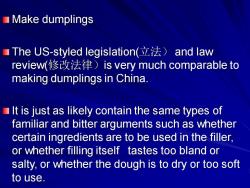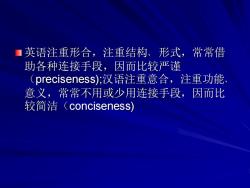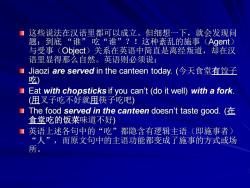《大学英语翻译》课程PPT教学课件(汉译英)第2讲 翻译中的形合与意合

中国农业大学人文与发展学院 外语系教案 课程名称:汉英翻译 单元主题:形合与意合 任课教师:赵挺 授课班级:英语071/072
中国农业大学人文与发展学院 外语系教案 课程名称:汉英翻译 单元主题:形合与意合 任课教师:赵挺 授课班级:英语071/072

■包饺子 ■美国人制订修改法律和中国人包饺子一样 就像中国人包顿饺子那样,馅用什么料, 咸了淡了,面和软了硬了,每每免不了要 番吵吵嚷嚷
包饺子 美国人制订修改法律和中国人包饺子一样 就像中国人包顿饺子那样,馅用什么料, 咸了淡了,面和软了硬了,每每免不了要 一番吵吵嚷嚷

Make dumplings ■The US-styled legislation(立法): and law review(修改法律)is very much comparable to making dumplings in China. It is just as likely contain the same types of familiar and bitter arguments such as whether certain ingredients are to be used in the filler, or whether filling itself tastes too bland or salty,or whether the dough is to dry or too soft to use
Make dumplings The US-styled legislation(立法) and law review(修改法律)is very much comparable to making dumplings in China. It is just as likely contain the same types of familiar and bitter arguments such as whether certain ingredients are to be used in the filler, or whether filling itself tastes too bland or salty, or whether the dough is to dry or too soft to use

I形合—hypataxis u意合-parataxis
形合—hypataxis 意合-parataxis

形合指的是句中的词语或分句之间用语言 形式手段(如关联词)连接起来,表达语法意 义和逻辑关系. ■意合指的是词语或分句之间不用语言形式 手段连接,句中的语法意义和逻辑关系通 过词语或分句的含义表达
形合指的是句中的词语或分句之间用语言 形式手段(如关联词)连接起来,表达语法意 义和逻辑关系. 意合指的是词语或分句之间不用语言形式 手段连接,句中的语法意义和逻辑关系通 过词语或分句的含义表达

■王力: “西洋语的结构好象连环,虽则环与环都联 络起来,毕竟有联络的痕迹,中国语的结构好 象无缝天衣,只是一块一块的硬凑,凑起来还 不让它有痕迹.所以西洋的语法是硬的,没有 弹性的;中文的语法是软的,富有弹性的
王力: “西洋语的结构好象连环,虽则环与环都联 络起来,毕竟有联络的痕迹,中国语的结构好 象无缝天衣,只是一块一块的硬凑,凑起来还 不让它有痕迹.所以西洋的语法是硬的,没有 弹性的;中文的语法是软的,富有弹性的

英语注重形合,注重结构、形式,常常借 助各种连接手段,因而比较严谨 (preciseness);汉语注重意合,注重功能 意义,常常不用或少用连接手段,因而比 较简洁(conciseness)
英语注重形合,注重结构﹑形式,常常借 助各种连接手段,因而比较严谨 (preciseness);汉语注重意合,注重功能﹑ 意义,常常不用或少用连接手段,因而比 较简洁(conciseness)

■今天食堂吃饺子。 ■叉子吃不好吃筷子吧。 口吃食堂味道不好
今天食堂吃饺子。 叉子吃不好吃筷子吧。 吃食堂味道不好

这些说法在汉语里都可以成立。但细想一下,就会发现问 题:到底“谁”吃“谁”?!这种紊乱的施事(Agent) 与受事(Object)关系在英语中简直是离经叛道,却在汉 语里显得那么自然。英语则必须说: Jiaozi are served in the canteen today.(今天食堂有饺子 吃) Eat with chopsticks if you can't (do it well)with a fork. (用叉子吃不好就用筷子吃吧)》 The food served in the canteen doesn't taste good. 食堂吃的饭菜味道不好)) 英语上述各句中的“吃”都隐含有逻辑主语(即施事者) “人”,而原文句中的主语功能都变成了施事的方式或场 所
这些说法在汉语里都可以成立。但细想一下,就会发现问 题:到底 “谁” 吃“谁”?!这种紊乱的施事(Agent) 与受事(Object)关系在英语中简直是离经叛道,却在汉 语里显得那么自然。英语则必须说: Jiaozi are served in the canteen today. (今天食堂有饺子 吃) Eat with chopsticks if you can’t (do it well) with a fork. (用叉子吃不好就用筷子吃吧) The food served in the canteen doesn’t taste good. (在 食堂吃的饭菜味道不好) 英语上述各句中的“吃”都隐含有逻辑主语(即施事者) “人”,而原文句中的主语功能都变成了施事的方式或场 所

1)江山易改,本性难移(隐含对比 It is easy to change rivers and mountains but hard to change a person's nature. 聪明一世,糊涂一时 Smart as a rule,but this time a fool. 2)良药苦口,忠言腻耳.(隐含类比) Faithful words offend the ears just as good medicine tastes bitter. 3)有饭大家吃(隐含条件) Let everybody share the food if there is any. 4)他老是见异思迁(隐含时间) He is always changing his mind as soon as he sees something new. 5)早知今日,何必当初?(隐含假设) If I had known it would come to this,I would have acted differently
1)江山易改,本性难移(隐含对比) It is easy to change rivers and mountains but hard to change a person’s nature. 聪明一世,糊涂一时 Smart as a rule, but this time a fool. 2)良药苦口,忠言腻耳.(隐含类比) Faithful words offend the ears just as good medicine tastes bitter. 3)有饭大家吃(隐含条件) Let everybody share the food if there is any. 4)他老是见异思迁(隐含时间) He is always changing his mind as soon as he sees something new. 5)早知今日,何必当初?(隐含假设) If I had known it would come to this, I would have acted differently
按次数下载不扣除下载券;
注册用户24小时内重复下载只扣除一次;
顺序:VIP每日次数-->可用次数-->下载券;
- 《大学英语翻译》课程PPT教学课件(汉译英)第4讲 词性转换.ppt
- 《大学英语翻译》课程PPT教学课件(汉译英)第6讲 长句的翻译.ppt
- 《大学英语翻译》课程PPT教学课件(汉译英)第7讲 公示语和翻译中的文化.ppt
- 《大学英语翻译》课程PPT教学课件(汉译英)第5讲 信息结构与翻译.ppt
- 《大学英语翻译》课程PPT教学课件(英译汉)Unit 2 Diction.ppt
- 《大学英语翻译》课程PPT教学课件(英译汉)Unit 4 Omission.ppt
- 《大学英语翻译》课程PPT教学课件(英译汉)Unit 3 Amplification.ppt
- 《大学英语翻译》课程PPT教学课件(英译汉)Unit 1 Translation Criteria.ppt
- 《大学英语翻译》课程PPT教学课件(英译汉)Unit 7 Passive Voice.ppt
- 《大学英语翻译》课程PPT教学课件(英译汉)Unit 8 Affirmative vs negative.ppt
- 《大学英语翻译》课程PPT教学课件(英译汉)Unit 5 Conversion.ppt
- 《大学英语翻译》课程PPT教学课件(英译汉)Unit 6 Restructuring.ppt
- 《大学英语翻译》课程PPT教学课件(英译汉)Unit 10 Attributive clauses.ppt
- 《大学英语翻译》课程PPT教学课件(英译汉)Unit 13 Long sentences.ppt
- 《大学英语翻译》课程PPT教学课件(英译汉)Unit 9 Splitting.ppt
- 《大学英语翻译》课程PPT教学课件(英译汉)Unit 11 and 12 Nominal clauses and adverbial clauses.ppt
- 《大学英语翻译》课程授课教案(口译)Module 2 Sight translation.doc
- 《大学英语翻译》课程授课教案(口译)Module 1 Introduction to interpreting course & lead-in.doc
- 《大学英语翻译》课程授课教案(口译)Module 3 memory training.doc
- 《大学英语翻译》课程授课教案(口译)Module 5 Consecutive interpreting.doc
- 《大学英语翻译》课程PPT教学课件(汉译英)第1讲 汉译英概论.ppt
- 《大学英语翻译》课程PPT教学课件(汉译英)第3讲 翻译中的句式衔接与布局.ppt
- 《大学英语翻译》课程PPT教学课件(口译)Module 6 Simultaneous interpreting.ppt
- 《大学英语翻译》课程PPT教学课件(口译)Module 5 Note-taking(2/2).ppt
- 《大学英语翻译》课程PPT教学课件(口译)Module 5 Consecutive interpreting.ppt
- 《大学英语翻译》课程PPT教学课件(口译)Module 5 Note-taking(1/2).ppt
- 《大学英语翻译》课程PPT教学课件(口译)Module 3 memory, retelling & summarizing.ppt
- 《大学英语翻译》课程PPT教学课件(口译)Module 2-3 sight translation(C-E).ppt
- 《大学英语翻译》课程PPT教学课件(口译)Module 4 Escort & liaison interpreting.ppt
- 《大学英语翻译》课程PPT教学课件(口译)Module 3 memory & summarizing.ppt
- 《大学英语翻译》课程PPT教学课件(口译)Module 2-1 sight translation(specific skills).ppt
- 《大学英语翻译》课程PPT教学课件(口译)Module 2-2 sight translation(speed control).ppt
- 《大学英语翻译》课程PPT教学课件(口译)Module 1 Introduction to interpreting course & lead-in.ppt
- 《大学英语翻译》课程PPT教学课件(口译)Module 4 Escort & liaison interpreting(Exercise).ppt
- 《大学英语》课程教学大纲(College English).pdf
- 《大学英语教程》课程教材配套电子教案(PPT教学课件,北大版)第一册 第四单元.pptx
- 《大学英语教程》课程教材配套电子教案(PPT教学课件,北大版)第四册 第八单元.pptx
- 《大学英语教程》课程教材配套电子教案(PPT教学课件,北大版)第一册 第三单元.pptx
- 《大学英语教程》课程教材配套电子教案(PPT教学课件,北大版)第四册 第四单元.pptx
- 《大学英语教程》课程教材配套电子教案(PPT教学课件,北大版)第一册 第二单元.pptx
